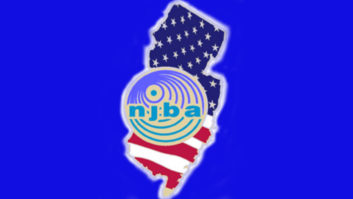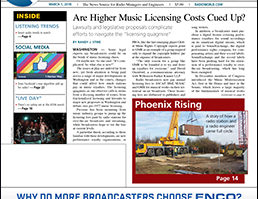WASHINGTON — Some legal experts say broadcasters could be on the brink of music licensing chaos.
Or maybe not. As one said: “It’s complicated. So what else is new?”
The issues at play are indeed far from new; yet fresh attention is being paid across a range of major developments in Washington and in the courts, changes that could affect how much stations pay in music royalties. The licensing quagmire, as one observer calls it, stems from a dizzying number of issues, from fractionalized licensing and lawsuits to major new proposals in Washington and debate over pre-1972 music licensing.
Pressure has been mounting from music industry groups to pump up the licensing fees paid by radio stations for over-the-air broadcasts and streaming, while broadcasters hope to toe the line at current levels.
A particular threat, according to those familiar with these developments, are new performance royalty organizations, or PROs, like the fast-emerging player Global Music Rights. Copyright experts point to GMR as an example of a group inspired only to expand the copyright holders’ pie at the expense of broadcasters.
“The only reason for a group like GMR to be founded is to try and drive up royalties for everyone,” said David Oxenford, a communications attorney with Wilkinson Barker Knauer LLP.
Radio broadcasters now pay annual licensing fees to ASCAP, BMI, SESAC and GMR for musical works on their terrestrial on-air broadcasts. Those licensing fees are disbursed to publishers and song writers.
In addition, a broadcaster must purchase a digital license covering performance royalties for sound recordings on its simulcast digital stream, which is paid to SoundExchange, the digital performance rights company, for compensating artists and their record labels. SoundExchange and the record labels have been pushing hard for the extension of a performance royalty to over-the-air broadcasting, which has long been exempted.

In December members of Congress introduced the Music Modernization Act, first in the House and later in the Senate, which leaves a large majority of the fundamentals of musical works licensing intact. The NAB originally balked, saying several provisions in the bill “may unjustifiably increase costs for many music licensees, including radio and TV broadcasters, who otherwise receive no benefit from the legislation.”
However, the association in January reached agreement with ASCAP and BMI on what can be introduced as new evidence into the rate-setting process. A source familiar with the negotiations says the original legislation would have changed copyright law by allowing sound recording royalty evidence to be introduced in ASCAP/BMI rate court proceedings for all music licensees, including over-the-air terrestrial and digital streaming.
“The agreement between NAB, ASCAP and BMI would narrow that change in law. It would only allow the introduction of sound recording royalty evidence for digital music services, eliminating the risk that this evidence could raise rates paid by terrestrial broadcasters,” according to the source.
A joint announcement in January by NAB, ASCAP and BMI read: “This agreement resolves NAB’s concerns with the potential introduction of new evidence into the rate-setting process while preserving ASCAP’s and BMI’s ability to seek meaningful compensation from the growing digital music marketplace.”
The announcement continued: “Our three organizations have enjoyed a long, unique and successful relationship, and as a result, we were able to work together to find a path forward on this important legislation that is fair to all parties.”
BMI told Radio World that broadcasters who engage in digital music services that are interactive, subscription-based or customizable will be subject to the introduction of the sound recording royalty evidence.
Several observers described the Music Modernization Act as being favorable to copyright holders and especially financially punitive to “pure play” digital streams, such as Pandora, Spotify and iHeartMedia’s digital services. The latest version of the act on Capitol Hill would only affect royalties for online streaming.
An NAB insider said the agreement greatly increases the chance for passage of the legislation this year. Separately, Kevin Goldberg, partner with Fletcher, Heald & Hildreth PLC in Washington, says that in light of the NAB agreement he believes it is “50/50” that Congress could pass the Music Modernization Act in 2018.
Broadcasters are again behind a proposal of their own. The House of Representatives appears to have enough support to pass the Local Radio Freedom Act, a resolution opposed to any new performance fee, tax, royalty or other charges of local radio broadcasters. A companion resolution has been introduced in the Senate.
“The Local Radio Freedom Act is the resolution that opposes sound recording royalty fees for performances on terrestrial radio. If they can get enough votes for LRFA, then clearly there will be no performance rights paid for over-the-air broadcast of radio stations,” Goldberg said.
Congress has surveyed performance rights for OTA broadcasting before. The Fair Play, Fair Pay Act of 2015, introduced in the House, would have required terrestrial radio stations to join satellite and internet radio in making payments to performers for their broadcast over the air. The bill languished.
MOVING PARTS
There are myriad moving parts to music licensing developments. For example, new deals reached between the Radio Music License Committee, ASCAP and SESAC in 2017 seemed to keep music licensing fees for broadcasters in line, observers said — even discounting them in the case of SESAC, when an arbitrator awarded RMLC-represented stations a more than 60 percent discount off the SESAC rate card through Dec. 31, 2018, according to a RMLC press release.
The RMLC represents the interests of the commercial radio industry — some 10,000 commercial radio stations — on music licensing matters. The new ASCAP deal runs through 2021.
The Copyright Royalty Board, a three-judge U.S. administrative body, set current rates for online simulcasting of music in 2015, even though it has never been finalized due to an appeal by SoundExchange. The CRB rates set for radio broadcasters’ streams were seen as a win for radio at the time, cutting the rate for commercial nonsubscription services paid by radio stations by up to 30 percent, while stream-only firms like Pandora and Spotify saw their licensing fees go up. The “Web IV” proceedings set rates through 2020. The CRB holds webcasting proceedings in five-year intervals.
The CRB rate ruling also reset music streaming fees higher in the case of some small commercial webcasters. That new higher rate structure squeezed small webcasters and partly contributed to the demise of the Internet hosting platform Live365, observers said.
In addition, the CRB issued final rules for rates and terms covering noncommercial public broadcasters effective Jan.19, 2018, through Dec. 31, 2022. Legal observers say the rate setting board nudged fees slightly higher with the new ruling.
Several lawsuits filed by music licensing groups appear poised for some sort of resolution, possibly by the end of this year barring earlier settlements, according to Karen Albin, a partner with Fletcher, Heald & Hildreth PLC.
An interim agreement is in place between GMR and RMLC, set to expire at the end of September 2018 though it could be extended again. It allows commercial broadcasters to play GMR musical works. The lack of a new agreement sparked lawsuits between the two groups centered on their inability to reach a long-term licensing deal, Albin said.
It is possible RMLC’s anti-trust lawsuit against GMR in Pennsylvania could be moved to California — seen as more favorable to copyright owners — and combined with GMR’s countersuit, Albin said, which is exactly what GMR asked for in January. GMR has a magistrate’s recommendation on its side that said the “Pennsylvania federal court RMLC filed its suit in is not the proper venue.”
The commercial radio licensing committee has had strong words for the Irving Azoff-led GMR, describing it as “an unlawful monopolist deploying a calculated scheme to extort the radio industry.”
Albin said it’s hard right now for radio broadcasters to avoid GMR music. “GMR has done a good job of getting just enough music that it is hard to avoid playing it,” Albin said.
The music industry scored a significant win in December 2017 when the Second Circuit Court of Appeals in New York ruled against the U.S. Department of Justice and affirmed BMI’s consent decree allowing the continued practice of fractionalized licensing. The court’s decision, slammed by NAB, Albin said, ironically vastly increased GMR’s market power since it “affirmed a BMI rate court decision green lighting fractionalized licensing of music,” Albin said.
“By affirming the BMI decree going forward, it helps GMR. Now if upstart GMR owns a fractionalized share of publishing rights in a song also shared by BMI, you’ll need to go get the GMR license as well,” Albin said.
The DOJ could still appeal the Circuit Court’s decision on fractionalized music licensing to the U.S. Supreme Court, according to observers, or bring an anti-trust enforcement action against BMI if DOJ believes fractionalized licensing is that bad, Albin added.
In fact, much of the unpredictability of 2018 is based on changes brought on by fractionalized licensing and the pain it could bring radio broadcasters. Fractionalized licensing requires broadcasters to license with multiple songwriters if more than one were credited on a composition. While not a new concept, fractionalized licensing could become more of a burden as broadcasters and their representatives are forced to deal with additional performance rights organizations.
Melody Virtue, a principal with Garvey Schubert Barer in Washington, said, “With co-written music, authors of a single composition can belong to different PROs. Historically, one co-author could grant a license for the entire composition. With fractional licensing, broadcasters need to be sure they have each individual co-author’s permission from the writers’ various PROs. In the future, it’s possible some songwriters might decide not to belong to a PRO. Then we would have music licensing chaos trying to gather up all the rights.”
Virtue recommends that her clients “budget some amount in 2018Ð19 for higher royalties for over the air broadcasts,” if fractionalized licensing sticks.
The fear is that “fractionalized licensing catches on,” Oxenford told Radio World, “and results in the formation of more PROs like GMR, which long term could encourage an even greater fractionalization of the music licensing world.”
VARIATIONS ON A THEME
Meanwhile, National Public Radio stations broadcasting musical works pay a music licensing rate negotiated with ASCAP, SESAC, the Harry Fox Agency and BMI by the Corporation for Public Broadcasting last year. GMR was not a participant in those negotiations.
Non-commercial radio stations affiliated with an educational institution pay music licensing fees typically tiered based on student enrollment. The new rates were published in the National Register in January 2018 and run through December 2022. CPB said the most recent agreement did not cover webcasting.
Student-run college radio stations are typically charged a licensing fee based on the school’s enrollment, say those familiar with radio music royalties.
Low-power FM broadcasters face their own challenges predicting music royalty rates in the years ahead, analysts said.
LPFMs typically pay lower rates than commercial broadcasters, observers said, with pay sometimes based on power level. An ASCAP spokesperson said low-power stations pay an annual fee based upon wattage. For example, a 15-watt LPFM pays less to ASCAP than a 100-watt LPFM station.
BMI’s contract for LPFM broadcasters stipulates an annual license fee of $352 in 2018, $359 in 2019 and $366 in 2020, according to a sample copy provided to Radio World. A LPFM must operate solely for religious, educational of governmental purposes and follow the guidelines set forth by the FCC, according to BMI.
Podcasting is easier to define but the environment is less favorable to broadcasters who want to podcast with music included, according to Goldberg of Fletcher, Heald & Hildreth.
“There’s no blanket license applicable to podcasting, so the podcast producer must get permission to use all copyrighted material, including musical works and sound recordings, contained in the podcast. It’s really just the same as producing a TV show,” Goldberg said.
In addition, most podcasts implicate the downloading/distribution rights rather than the public performance right, he said, particularly with respect to sound recordings included in podcasts, there “is no centrally established licensing mechanism from which to secure such rights,” so podcasters need to negotiate with each individual record company whose recordings are incorporated into a podcast.
OLDER CONTENT
The pre-1972 music licensing flap, according Albin, is in a “state of flux” while playing out in multiple courts in several states.
A merry-go-around of lawsuits targeting broadcasters for the pre-1972 music they play began in early 2015. There was no federal copyright protection for sound recordings until Feb. 15, 1972. Prior to that, sound recordings were protected under a patchwork of state laws. That prompted several groups to seek performance royalties for the libraries of songs they controlled.
“You have New York, Illinois and Florida courts that have said no to performance rights for pre-1972 music, so that’s good for broadcasters. A bigger threat is a lower court in California that says there is a performance right and they have stronger state statutory language to back that up. It’s been setting on certification to the high state court of California for awhile now with no decision,” Albin said.
She continued, “If the California lower court decision is reaffirmed, then radio stations could conceivably owe a performance fee for the pre-1972 music they play over the air even though they do not pay a performance fee for the post-1972 music they play on air.”
Text has been updated to correct an earlier typo referring to BMI rather than ASCAP in the LPFM example paragraph.












